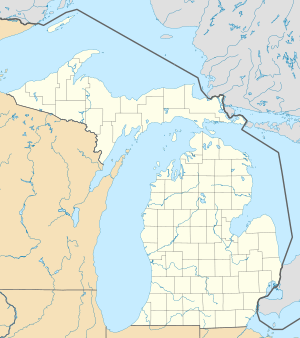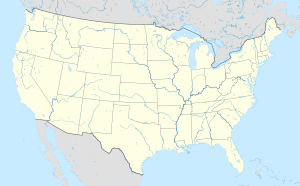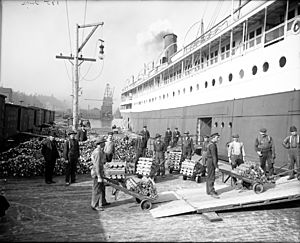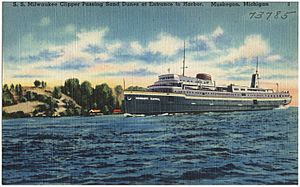SS Milwaukee Clipper facts for kids
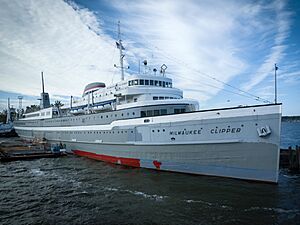
The SS Milwaukee Clipper in September, 2024.
|
|
| History | |
|---|---|
| Name |
|
| Owner |
|
| Operator | Milwaukee Clipper Preservation INC |
| Route | Muskegon to Milwaukee |
| Ordered | 1904 |
| Builder |
|
| Way number | 1190 |
| Laid down | 1904 |
| Launched | December 22, 1904 |
| Christened | 1904 |
| Completed | 1905 |
| Acquired | 1905 |
| Maiden voyage | As rebuilt, June 3, 1941 |
| Identification |
|
| Status | Docked in Muskegon, Michigan |
| Notes | Museum Ship |
| General characteristics | |
| Tonnage | |
| Length | 361 ft (110 m) |
| Beam | 45 ft (14 m) |
| Height | 89 |
| Draft | 19 |
| Depth | 28 ft (8.5 m) |
| Decks | 6 |
| Installed power | American Quadruple Expansion Steam |
| Propulsion | Single Screw |
| Speed | 18 knots (33 km/h; 21 mph) |
| Capacity | 900 Passengers |
| Crew | 55 Crew |
| Notes | Last Ship of Her Kind |
|
SS Milwaukee Clipper (passenger steamship)
|
|
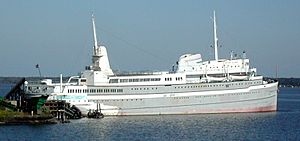
Milwaukee Clipper docked at Muskegon, Michigan
|
|
| Location | Grand Trunk Ferry Dock Muskegon, Michigan (formerly Chicago, Illinois and Hammond, Indiana) |
| Area | Muskegon |
| Built | 1904, Rebuilt 1941 |
| Architect | American Shipbuilding Co. Redesigned in 1940 by George G. Sharp |
| Architectural style | Art Deco, Streamlined Moderne |
| NRHP reference No. | 83003570 |
| Significant dates | |
| Added to NRHP | December 8, 1983 |
| Designated NHL | April 11, 1989 |
The SS Milwaukee Clipper is a famous old ship. It used to carry both people and cars across the Great Lakes. This amazing ship sailed on all the Great Lakes except Lake Ontario. Today, you can find it docked in Muskegon, Michigan, where it is a museum.
Contents
The Ship's Early Life: Juniata
The ship we know as the Milwaukee Clipper first launched on December 22, 1904. It was built in Cleveland, Ohio, by the American Shipbuilding Company. When it first launched, its name was Juniata.
The Juniata was built for the Anchor Line. This was the Great Lakes shipping part of the Pennsylvania Railroad. The Juniata had two sister ships, the SS ''Tionesta'' and the SS Octorara.
The ship is about 361 feet (110 m) long and 45 feet (14 m) wide. It could carry 350 passengers and travel at 18 knots (about 21 miles per hour). When it was first built, it had a steel body and a wooden top part. For the Pennsylvania Railroad, it carried passengers and goods between Buffalo, New York and Duluth, Minnesota.
In 1915, a new law called the Panama Canal Act came into effect. This law stopped railroads from owning steamships. Because of this, the Pennsylvania Railroad had to sell its Anchor Line. The Juniata was then sold to the Great Lakes Transit Corporation. It continued to carry passengers on its usual routes for another 20 years.
In 1933, the Juniata took passengers to the Chicago World's Fair. However, by 1936, the ship was put out of service. This was due to tough economic times and new safety rules for wooden passenger ships. These rules came after a big ship fire called the Morro Castle disaster.
Becoming the Milwaukee Clipper
The Juniata stayed docked in Buffalo until 1940. Then, the Wisconsin & Michigan Steamship Company bought it. This company was owned by the McKee family. They decided to rebuild the ship to use it for passengers on Lake Michigan.
Modernizing the Ship
The Juniata was completely updated at the Manitowoc Shipbuilding Company.
- Its engines were changed to burn fuel oil instead of coal.
- The old wooden cabins and top parts were removed.
- New steel parts were added to meet modern fire safety rules. These rules were made after the SS Morro Castle fire in 1934.
The ship's new front smokestack looks sleek, but it doesn't actually let out engine smoke. This design was a special touch by naval architect George G. Sharp. He was known for his ideas about making ships fireproof. This type of stack became common on many new ships. George Sharp also designed two other famous ships: the SS Lane Victory and the NS Savannah.
New Features and Journeys
The modernized ship had many new features for passengers:
- Air-conditioned rooms
- A children's playroom
- A movie theater
- A dance floor with live music
- A soda fountain and a bar
- A cafeteria and lounges
- A sports deck
It could also carry 120 cars. On June 2, 1941, the ship was renamed Milwaukee Clipper. Patricia McKee, whose family owned the ship, officially christened it. The very next day, it made its first trip from Milwaukee to Muskegon.
As the Milwaukee Clipper, the ship sailed between Muskegon and Milwaukee for 29 years. It also took passengers on trips around Lake Michigan. People called it the "Queen of the Great Lakes." In the summer, it carried about 900 passengers and 120 cars.
The ship used about 5,500 gallons of oil for each round trip. On weekdays, it made two round trips, each taking 7 hours. On weekends, it made three shorter, 6-hour round trips. The crew had about 105 to 109 people. About 55 of them worked in the steward's department, taking care of the passengers. In the 1950s, a ticket cost $3.33, and it was $8.00 extra to bring a car.
A Trip with a Twist
During its first year, a company put some entertainment devices on the ship. These devices were covered when the ship was in port. Once the ship was three miles from shore, the covers were removed.
On July 25, 1941, two officers boarded the ship to investigate. The ship's captain, Allen K. Hoxie, gave orders for the ship to leave the dock. Once the ship was in the middle of the lake, the officers were told they no longer had authority over the ship. One officer used the ship's "ship-to-shore" telephone to tell authorities in Milwaukee about the situation. When the ship docked in Milwaukee, the devices were taken off the ship.
Wartime and Later Years
During World War II, the Milwaukee Clipper helped by moving defense materials between Muskegon and Milwaukee. The ship also had agreements with car companies to carry new cars throughout its time in service. The main passenger season was from May to September. After that, it could carry fewer passengers but still up to 250 cars.
On January 6, 1949, while getting ready to leave Milwaukee, a strong gust of wind hit the ship. This caused the back of the ship to swing and hit a concrete barrier. The ship's rudder broke off, and other parts were damaged. The ship had to be towed for six weeks of repairs.
By 1970, there were plans to replace the Milwaukee Clipper with a newer, larger ship called the Aquarama. However, these plans did not work out. Even though 1970 was a very busy year for the Milwaukee Clipper, it stopped its regular route after that year.
A Museum Ship Today
In 1977, a group from Chicago bought the Milwaukee Clipper. They wanted to use it for trips between Chicago and Milwaukee. But their financial support fell through, and the ship was taken by the U.S. Marshal. After some legal cases, the ship was returned and towed to Chicago in 1980. The plan was to use it as a museum ship.
In December 1983, the Milwaukee Clipper was added to the National Register of Historic Places. In May 1989, it was named a National Historic Landmark. You can see both of these special plaques on board the ship today.
In 1990, the ship was sold to Hammond, Indiana. It became the main attraction for their new marina. Later, a new casino ship replaced the Milwaukee Clipper. The Clipper was then moved to South Chicago. On December 2, 1997, it was sold again to be a museum in Muskegon, Michigan, its old home port.
Today, the Milwaukee Clipper is docked in Muskegon, Michigan. It is at the old Grand Trunk Ferry dock. Volunteers from the SS Milwaukee Clipper Preservation, Inc. organization are working to restore it.
In the summer, visitors can tour parts of the ship. You can see the pilothouse, some passenger rooms, crew quarters, the dance floor, soda fountain, and movie theater. Many of the original Art Deco style furniture pieces are still on board. Warren McArthur designed this furniture, and it was made from aluminum. Each piece is unique. There are also displays of items from both the Juniata and Milwaukee Clipper eras. These include memory books, photos, brochures, and dishes. The Clipper still has the last American Quadruple Expansion Steam Engine.
Media and Its Story
A 45-minute documentary film, The Milwaukee Clipper: A Legend Saved, was made in 1997 by filmmaker Mark Howell. It was shown on PBS. The film includes interviews with people who worked on the ship. It also has restored color film footage of the Milwaukee Clipper's christening, its voyages, and other operations.
See also
- Lake Express, a ferry service that started in 2004 on the same route
- U.S. Route 16, a road route that the Milwaukee Clipper helped connect across Lake Michigan
- SS Keewatin
- SS Badger


